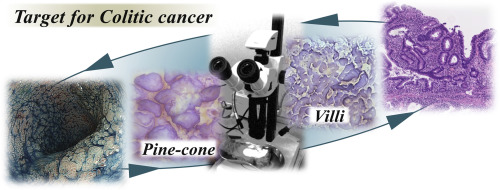Post written by Takahide Shinagawa, MD, from the Department of Surgical Oncology, The University of Tokyo, Tokyo, Japan.

How to survey colorectal cancer is one of the main problems in managing patients with ulcerative colitis (UC). Currently, colonoscopic surveillance is the gold standard and targeted biopsy for the suspicious lesions has become the focus of attention. However, unlike sporadic colorectal cancer, UC-associated cancer (CAC) or dysplasia is difficult to detect due to background inflammation and the flat configuration of the tumor, and targeting neoplastic lesions in surveillance colonoscopies still proves difficult especially for many non-specialists. Therefore, we consider it vital to elucidate suggestive endoscopic findings for neoplastic lesions that not only specialists, but also non-specialists can detect.
This study consisted of 2 parts. First, we used stereomicroscopy for surgical specimens from 15 patients with UC, containing a total of 25 neoplastic lesions. We created 769 magnified images, and 2 evaluators independently evaluated each image for Kudo’s pit pattern classification (Type I and II for non-neoplastic pit and Type III to V for neoplastic pit), as well as for surface morphology, such as pine-cone or villi patterns in blind to pathological diagnosis. The correlations between surface findings and pathological diagnosis (neoplasia or not) were analyzed and diagnostic values were calculated. Second, we validated the results using magnifying colonoscopy images from 26 patients with UC, with a total of 39 neoplastic lesions. Again, 2evaluators evaluated the images, and correlations between the endoscopic findings and pathology were also calculated.
As a result, neoplastic pit patterns and pine-cone or villi patterns showed a high specificity of 90% and 97% for neoplastic lesions, respectively. These results indicate that neoplastic pit patterns including pine-cone or villi patterns should be biopsied in surveillance colonoscopies. Validation by magnifying colonoscopy showed a similar trend. However, some flat neoplastic lesions presented as non-neoplastic pit patterns in both stereomicroscopy and magnifying colonoscopy. It is important to be cautious at this point since there could be some hidden neoplastic lesions under almost normal, non-neoplastic surface structures, and targeted biopsy alone may have some pitfalls in overlooking such lesions. Our sub-analysis for flat neoplastic lesions with non-neoplastic pit patterns showed that “redness” was one of the most supportive findings in detecting such lesions.
Our results may add some supportive information on targeted biopsy in surveillance colonoscopy for patients with UC. Kudo’s neoplastic pit patterns including pine-cone or villi patterns, are very important endoscopic clues for targeted biopsy. However, it should also be noted that they are not findings exclusive to neoplastic lesions because the sensitivity was quite low in pine-cone or villi patterns (21%), and not as high in neoplastic pit patterns (77%). Additionally, there could still be some hidden flat neoplasia without any neoplastic pit patterns, therefore performing random biopsies, paying attention to “reddish areas,” may aid in the detection of such lesions.
I hope this study can shed some light on creating a better understanding on the morphology of CAC or dysplasia.

Read the full article online.
The information presented in Endoscopedia reflects the opinions of the authors and does not represent the position of the American Society for Gastrointestinal Endoscopy (ASGE). ASGE expressly disclaims any warranties or guarantees, expressed or implied, and is not liable for damages of any kind in connection with the material, information, or procedures set forth.
